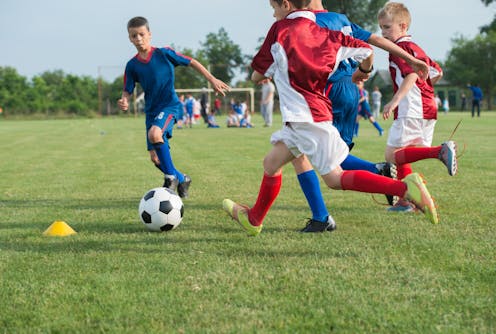New research suggests concussion risks can be outweighed by the benefits of playing sport
- Written by Matt Lennon, Conjoint Lecturer, UNSW Sydney

CTE: Chronic Traumatic Encephalopathy.
It is the now popularised term that makes athletes, parents, sports administrators and insurers’ knuckles white with anxiety as sports codes struggle to come to grips with the risks and impacts of concussion.
In 2005, Bennet Omalu, a United States-based neuropathologist, published a case of an NFL player who had suffered from CTE.
Over the following years, public anxiety about head injuries grew, with the 2015 movie Concussion bringing it to the forefront of public attention.
Omalu, famously played by Will Smith in that movie, wrote at the time that “high-impact contact sports […] place athletes at risk of permanent brain damage” and argued kids should not be allowed to participate in contact sports.
The movie Concussion brought the issue of CTE to the public’s attention.Since then, sports codes from across the world have tried to reduce the risks of concussion, and athletes and parents have pondered whether contact sports are worth the risk of brain injury.
The risks and benefits of sport
Over the past few decades, rates of physical activity and sporting participation in Australian children have declined.
In Australia, according to the Australian Bureau of Statistics’ 2022 data, only one in 20 (5.6%) young people (5–17 years) met the physical activity guidelines.
According to a report by the Australian Sport Commission, around 40% of young people do not participate in any organised sport.
There are many reasons why childhood physical activity may be declining, including more online entertainment options, reduced time allocation of physical education in schools and higher rates of obesity.
But having had many conversations with worried mothers and fathers, the fear that their child will have permanent brain damage, a stunted lifespan or a more rapid onset of dementia is real and a likely driver to avoid contact sport.
But what evidence is there that this is the case?
The honest answer is very little – which is why the 2022 International Consensus Statement of Concussion in Sport identified that studies looking at long-term outcomes of sports-related concussions was the highest priority area for future study.
The most studied area within the field is the long-term outcomes of active and retired professional American football players.
Clearly, the genuine and well-founded health concerns about 160kg NFL players clashing heads day in, day out cannot be generalised to your average school boy or girl playing rugby, Aussie rules or basketball.
This grey area prompted a team of researchers, including myself, from the UK, Australia and the US to take on the largest study to date examining the long-term cognitive outcomes of sports-related concussions.
The findings, just published, turn the field on its head.
What we found
In a longitudinal study of 15,000 UK-based adults between the ages of 50 and 90, we found those who had experienced a sports-related concussion at some point in their lives had better working memory and verbal reasoning than those who had never experienced one.
In a further analysis, we found those who had experienced two or three (or more) sports-related concussions did not perform better than those without a concussion history, but equally they did not perform any worse on any measure.
By contrast, those who had experienced three or more other types of concussions (such as from falling, motor vehicle accidents or assaults) had significantly worse processing speed and attention.
Importantly, the study examined “everyday” adults and the results are not applicable to professional athletes whose head injuries tend to be more frequent, debilitating and severe.
New research suggests non-professional athletes who have suffered a sport-related concussion are at lower risk of cognitive issues.Getting the balance right
While at first glance you may feel puzzled by these results, a brief consideration of some modern realities makes them seem sensible.
Rates of obesity in Australia have been steadily climbing over the past few decades and as of 2022, 31.1% of Australians are obese and 33.7% are overweight.
Similarly, rates of diabetes and high blood pressure are at historic highs.
Many Australians are physically inactive, with teenagers and young adults clocking up an average of 6.6–7.5 hours of screen-based activity a day and reporting concerningly high levels of isolation and loneliness.
While many sports come with risks of head injuries, the beneficial effects on physical activity, obesity, diabetes, hypertension, and social connectedness likely more than mitigate the damaging cognitive effects of a head injury.
The obvious reply to this is we should encourage “safer” physical activity options and do everything we can to protect those in contact sports from injuries.
This is a sensible point of view but requires a few qualifications.
The first is, sports that are more physically demanding (and therefore possibly deliver greater benefits from physical activity) often have greater contact and risk of concussion (for example, golf has fewer concussions than Australian football).
Secondly, even “lower-risk” sports such as cycling or soccer carry a risk of head injury – I have personally been concussed while cycling, although I don’t remember it all that well.
It goes without saying that sporting bodies should continue to minimise the risk of head injuries because the individual effects of concussion can be devastating.
But what our study suggests is perhaps the greater risk is to attempt to take no risks at all – and that the benefits from playing sport may outweigh the effects of concussions.
Authors: Matt Lennon, Conjoint Lecturer, UNSW Sydney





